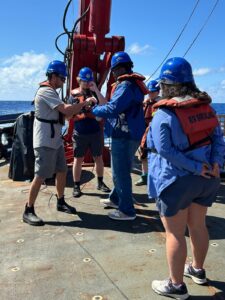Today (Feb. 4, 2025) was the first full day of action aboard the R/V Sikuliaq, which was full of scientific discovery and wonder. Around 13:00, I was given the pleasure of dropping a XBT (Expendable Bathythermograph) into the ocean while the ship was in motion. The bathythermograph measures the temperature of the water as it falls deeper and deeper. Since we know the rate that the XBT falls, we can create profiles for other measurements based off temperature alone. To operate the bathythermograph, one fastens the end of the holster to a power source (wonderfully enough, our power source was inside the hollow of a crane!) and places the cannister inside of the holster. The holster has a fitted place for the pin located on the side of the cannister, so you know exactly how to fit the cannister in the holster. Once fitted, the cannister is secured, and the top is opened. Given the okay, the holster is then leaned down over the side, and the XBT inside drops deeply into the water as the vessel glides along.


A couple of hours after the detachment of the XBT, the STEMSEAS crew was given a brief but ample presentation by Julian, an IT and oceanographic specialist. He talked with us about the satellites that are deployed to give ships in a specific region internet while at sea. Julian also mentioned the problems that come with these satellites, such as bandwidth, connectivity, and a sort of hold that the company Starlink has over this product due to its innovation. Starlink has found a way to put smaller satellites in the sky, dozens at a time in fact. Although this could lead to problems down the road, it’s clear the company has a product that many are willing to pay for hence Starshield.


